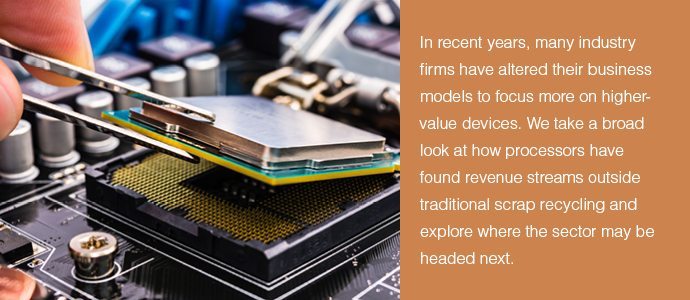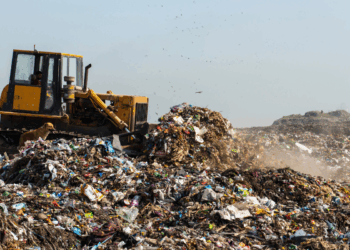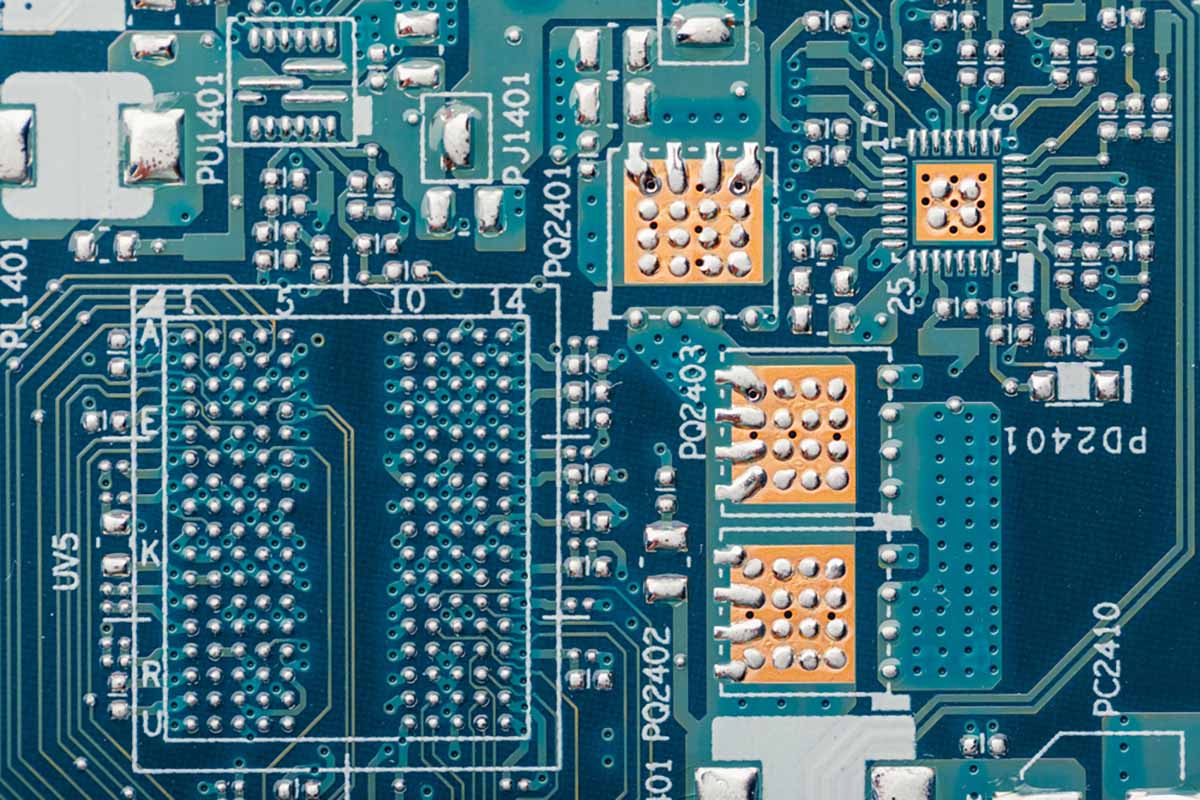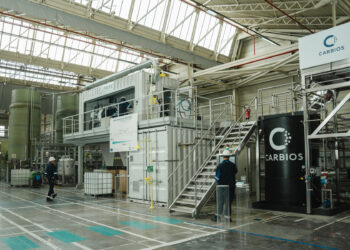This article originally appeared in the September 2017 issue of E-Scrap News. Subscribe today for access to all print content.
In January of 2017, Cascade Asset Management released a report that underscored a seismic shift taking place in the e-scrap industry.
The Madison, Wisc.-based firm noted that on the one hand volatility in the commodities market had been continuing to put a damper on traditional recycling operations across the country. High-profile closures, increased scrutiny on e-scrap export activities and CRT abandonments weren’t helping the industry’s image either.
But on the other hand, the Cascade report pointed out that interest in services related to ITAD (IT asset disposition) was picking up steam. For example, the value of laptops, desktops and mobile phones refurbished and sold by the company in 2016 increased by 21 percent.
For a company like Cascade, which was founded in 1999 and began focusing exclusively on ITAD in 2008, offering a breadth of reuse-related services acted as a buffer against movements in metals values and other global factors.
“By focusing on the ITAD needs of businesses and institutions, we could enjoy a more diverse and sustainable revenue structure and build lasting, quality relationships with organizations by supporting their ongoing refresh and disposition projects,” Neil Peters-Michaud, Cascade’s CEO, told E-Scrap News.
Cascade is not alone in eyeing those opportunities. Over the past several years, a number of large e-scrap players have expressed their intentions to focus less on traditional scrap recovery and more on refurbishment, remarketing and data security. And newer businesses have emerged to try to leverage skills in those areas.
“It’s a permanent shift,” said Bill Baron, the owner of Peachtree Corners, Georgia-based ITAD Tech, which was founded in 2014. “Over time, commodities will go up and go down and it’s foolish to believe otherwise. Trying to build a sustainable business model based solely on commodities is buying into a boom or bust mentality. It’s simply shortsighted.”
‘We never were scrap-oriented’
In exploring the development of ITAD and its growth potential, it can be helpful to have a clear view of what ITAD actually means.
Many ITAD firms have generated profits by harvesting parts, such as computer memory, and leveraging those components as they repair and resell devices.
The concept is defined in different ways by different people, but at its core, ITAD is a catchall term for a wide range of asset management services, including data destruction, repair and reuse, and parts harvesting.
And the ITAD industry itself is not new. E-scrap companies of all sizes have been building services beyond commodities recovery into their strategies for decades. Of late, however, more firms are making it a point to downplay traditional scrapping.
“We are not a recycling company,” said Linda Li, the chief strategy officer at Re-Teck, an ITAD firm with four locations in the U.S. Re-Teck was founded in 2015 as a subsidiary of the Li Tong Group, which owns 21 e-scrap facilities around the world.
A similar sentiment was expressed by Lane Epperson, the president and CEO of Oklahoma City-based HiTech Assets, which was founded in 2002. “We never were scrap-oriented,” he said. “We came at it from a different direction.”
Billy Johnson, the chief lobbyist of the Institute of Scrap Recycling Industries, told E-Scrap News he sees the group’s e-scrap members increasingly marketing reuse and repair as their go-to business offering.
“The world has changed for us … and our e-scrap members are reacting to that as quickly as they possibly can,” Johnson said.
For many companies, ITAD is presented as just one segment of a larger suite of offerings.
ERI, one of the largest e-scrap processors in the U.S., expects to handle more than 300 million pounds of electronics this year at its eight U.S. facilities (seven of those sites engage in processing, and one is a consolidation location). Kevin Dillon, the company’s chief marketing and sales officer, said the company has always incorporated repair and reuse, but he added there’s value in giving clients options on the disposition front.
“We do what the customer wants,” Dillon said. “If the customer wants us to shred it, we shred it. If the customer wants us to refurbish it and reuse it, we do that.”
Nevertheless, ITAD has become a focus for the firm. According to Dillon, “an aggressive marketing push” over the last five years has looked to frame ERI as a one-stop shop for electronics management, and a parts harvesting project with iFixit kicked off in 2015.
He added that about half of the tonnages handled by the company this year will go toward repair, reuse and parts harvesting. And he said 70 percent of ERI’s revenue now derives from non-recycling activities.
In fact, the company officially changed its name in 2016 from Electronic Recyclers International to ERI because “the R stands for both recycling and reuse,” Dillon noted.
Changing model as markets move
A handful of key factors have driven the industry at large to embrace repair and reuse. First and foremost is the ever-shifting commodities market.
The Cascade report noted e-scrap commodity prices took a nosedive between 2011 and 2015. Gold prices dropped 36 percent in that span, copper prices dropped 69 percent and iron prices went down 71 percent. Some values have rebounded of late, but uncertainty lingers.
That’s caused firms that previously focused on scrap commodities to explore alternative revenue sources, noted Mark Chodos of e-scrap software company Makor Solutions.
“The price drop in commodities is forcing a lot of recycling companies to rethink where they can get more value for the products they’re getting,” Chodos said. According to Chodos, Makor has some clients that were previously geared entirely toward scrap but now generate 90 percent of their business through ITAD services.
As businesses have aimed to reduce reliance on commodities, they’ve also shifted strategies in terms of material procurement.
Sims Recycling Solutions (SRS), the e-scrap wing of publicly traded Sims Metal Management, is one big name that’s recently pivoted away from traditional recycling. Citing issues with stipulations laid out in extended producer responsibility programs for electronics as well as struggles with low-value municipal material, SRS phased out its presence in Canada and closed processing sites in three U.S. states in 2014.
The consolidation effort has helped the firm target higher-value devices and equip each of its remaining eight U.S. facilities with broader ITAD capabilities, according to the company.
“You can’t trade volume for profitability, and I think a lot of companies will make that mistake, especially in the scrap business,” said Sean Magann, SRS’s vice president of sales and marketing. “Being from the scrap industry, I think maybe we fell victim to that. … And we didn’t want to make that trade-off anymore. We said, ‘Let’s be more judicious about what we buy.’”
Another factor underpinning the broader move toward ITAD is the shear number of repair-ready devices available.
With consumers showing an insatiable appetite for the latest technological innovations, the e-scrap industry is seeing more and more high-value devices streaming into their facilities, said Johnson of ISRI.
Original equipment manufacturers (OEMs) are also increasingly looking to create a circular economy for their products, entering into revenue-sharing arrangements with ITAD firms that are able to repair and resell devices.
The industry’s embrace of repair and refurbishment has included both long-standing e-scrap companies and newer firms that have a specific ITAD focus.
Li at Re-Teck says her firm has partnered with many of the biggest names in the electronics industry, including Amazon, Google and Apple, to provide services such as repair and parts harvesting. Re-Teck, for instance, manages all devices sent through Amazon’s Recycling Portal, a tool that allows consumers to send in select used electronics free of charge.
The company’s three locations in Texas and new site in California’s Silicon Valley can together handle up to 5 million devices per year.
“There’s huge demand out there,” Li said.
Profit potential
Stakeholders say when ITAD strategies are implemented effectively, a boost to the bottom line naturally follows.
“Companies are … making a quarter or a dollar by recycling a product, or they can make 100 bucks on that same product if it can be reused,” said ISRI’s Johnson.
Sarah Cade and Mike Cheslock recently launched an ITAD consultancy called E-Reuse Services. In their view, “not every electronics recycler is a good candidate for adding reuse and/or repair,” but if the fit is right, the profit potential can be “substantial.”
A big chunk of that revenue can come via data security. The long list of major corporate data breaches in recent years has grabbed the attention of decision-makers at companies of all sizes. ITAD firms that already target equipment from the enterprise arena have been quick to develop solutions when it comes to wiping drives and ensuring secure asset management.
“Data destruction is a natural component of reuse operations, but by itself, it can prove to be its own profit center for organizations whose customers are concerned about data protection,” Cade and Cheslock wrote in an e-mail.
ERI lists data destruction services prominently on its website, and it now offers customers a tool called MyTrackTech that lets them keep tabs on individual assets as the products move through the disposition process.
Peters-Michaud at Cascade noted it can take years to build lasting and lucrative relationships with partners. Once the partnership is in place, however, ITAD firms can leverage that trust.
“It’s been a slow and steady road working with businesses and institutions to make more thoughtful and effective decisions related to their ITAD strategy,” Peters-Michaud said. “Asset disposition is generally the last thing organizations think about when they also need to focus on the procurement and management of their IT infrastructure.”
Of course, part of handling used devices in a secure manner is knowing where material is going after it leaves the processing plant.
Dillon of ERI said “about 90 percent” of reusable devices and parts handled by the company are moved to entities in the U.S.
Johnson of ISRI, meanwhile, said the marketplace for refurbished devices and working parts is fully globalized. “If I can take the screen off of my iPhone, someone in Japan might want it or someone in India might want it,” Johnson said.
Li at Re-Teck said her company sends parts to repair shops and OEMs in North America, but she noted the market for refurbished, working devices is most robust overseas.
“Secondhand products are a bit tricky,” Li added. “The demand for secondhand devices is not as strong in North America as it is in other parts of the world. … So in some cases, whole products could be exported.”
Chodos at Makor noted that domestic demand for refurbished products is generally tied to a product’s type, age and make. Older devices that have been used for more than three years “are ending up in developing nations,” he said.
The future of the industry, the future of ITAD
Not everyone believes recycling companies will remain committed to ITAD going forward. Epperson of HiTech Assets noted that if the commodity market rises significantly, small and midsized firms will jump ship fairly quickly.
“It’s a very, very competitive market and always has been,” Epperson said of the ITAD space. “As scrap prices improve, I think folks will go back to what their comfort zone is.”
Other companies have resisted the move toward ITAD altogether, instead remaining committed to recycling as a core and necessary business. It will always be true that a sizable segment of the stream will be made up of devices that are so old or broken they hold no refurbishment value.
OEMs are increasingly entering into revenue-sharing agreements with ITAD companies that are able to repair and resell devices.
NovoTec is a prominent Columbus, Ohio-based processor that has made a name for itself in handling CRT glass, a material ITAD-focused operations – and even traditional recycling operations – try to avoid due to its limited downstream markets.
Tom Bolon, NovoTec’s president, said the firm regularly discusses the potential of adding an ITAD team, but thus far has remained committed to being an expert in recycling CRTs. NovoTec also plans to become a destination for flat panel TVs and displays as that profit-challenged stream begins to ramp up.
“We started, and still are, an end-of-life recycler,” Bolon said. “One of the pillars we built NovoTec on was ‘Do one thing and do it right.’”
Bolon noted that many of NovoTec’s upstream clients and partners are involved in refurbishment and parts harvesting, but almost all of them need recycling partners to handle the devices that can’t be repaired. “We’re the outlet for that,” Bolon said.
Multiple executives in interviews reiterated the importance of recycling. Though Re-Teck’s Li puts an emphasis on ITAD, she did acknowledge recycling will always be a necessity to some degree as well. “Whatever cannot be reused or repurposed goes into the recycling stream,” Li said.
Epperson at HiTech noted his firm still sends about 35 percent of devices toward downstream recycling.
Dillon at ERI went further, saying that recycling is more critical than repair and reuse “because that’s where all the brand protection is for the customer.”
Still, as companies look to keep profits healthy – and prepare for whatever market surprise comes next – ITAD seems set to remain a key part of the business equation.
“Unless an organization’s scope is set and unchanging, the growth of the ITAD services space should only be a positive thing,” wrote Cade and Cheslock. “The demand for electronics reuse suggests that we are a long way from a market saturated with providers.”
And with the North American device stream flush with valuable devices, ISRI’s Johnson predicted more companies would be rethinking their overall strategies.
“The volume is staggering, but the financial value of it is mind-blowing,” Johnson said.
Bobby Elliott is editor at large for E-Scrap News. He can be contacted at [email protected]


























